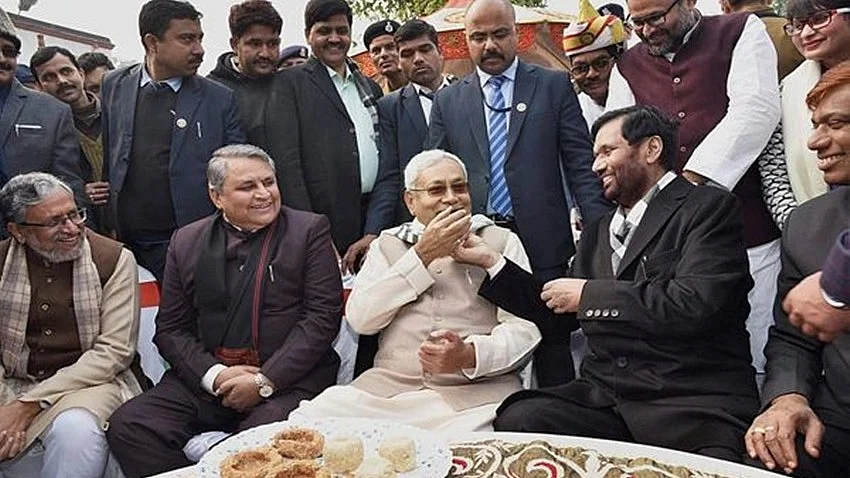
Bihar's 'Dahi-Chura' Feast Gives a Taste of Upcoming Poll Politics
Once purely cultural gatherings, these 'feasts' have become crucial barometers of shifting alliances and ambitions.

advertisement
The age-old tradition of dahi-chura (flattened rice in yogurt) feasts during the festival of Makar Sankranti in Bihar has transformed into a sophisticated political theater where power dynamics are negotiated, alliances tested, and electoral strategies subtly orchestrated.
At the heart of this drama stands 10, Circular Road, the residence of former chief minister Rabri Devi, and the historic headquarters of the Rashtriya Janata Dal (RJD) — a venue that encapsulates Bihar's shifting political currents.
Last year, amid the aroma of dahi-chura and jaggery, Nitish Kumar’s presence at the RJD’s feast symbolised unity within the Mahagathbandhan. In 2025, however, the political stage has shifted dramatically. The camaraderie of the past has given way to sharp political jibes, with Kumar's realignment with the Bharatiya Janata Party (BJP) dominating Bihar’s discourse. These feasts, once purely cultural gatherings, have become crucial barometers of shifting alliances and ambitions.
Nitish Kumar: From Feast-Hopping to Political Realignments
Kumar’s attendance at these feasts has long served as an indicator of political shifts.
His 2017 visit to Lalu Prasad Yadav's residence, where he dismissed speculation of discord, preceded his dramatic return to the BJP. A similar pattern emerged in 2024, when, despite being a key figure in the Mahagathbandhan, he orchestrated yet another political pivot shortly after celebrating Makar Sankranti with Lalu’s family.
The 2025 celebrations underscored Nitish’s political maneuvering with even greater precision. His early arrival at Chirag Paswan’s feast — before the host was free to engage — hinted at a potential rapprochement within the NDA.
Equally significant was his presence at the gathering hosted by rebel RJD MLA Chetan Anand, son of Anand Mohan, signalling a continued strategy of maintaining political relevance and flexibility. These calculated moves reinforce his adaptability in Bihar's fluid political landscape, keeping analysts on their toes.
The Paswan Factor: Feast Politics and Family Feuds
The contrasting feasts of Chirag Paswan and his uncle Pashupati Paras provided insight into Bihar's evolving political dynamics, particularly the intersection of family rivalries and strategic calculations. These separate gatherings highlighted the growing divide within the Paswan family, a key force in Bihar's Dalit politics.
Chirag’s invitation to Nitish Kumar signalled a tactical shift, reflecting Bihar’s political reality where caste calculations and power pragmatism often override ideological divides. Meanwhile, Paras’s decision to invite Lalu marked an unexpected reversal of alliances. The sight of his supporters chanting pro-Lalu slogans at what was once an NDA-aligned event underscored a desperate bid to retain political relevance as the BJP increasingly favours Chirag.
RJD and BJP: Competing Narratives and Coalition Dynamics
The response of Bihar's major political forces to these shifting alignments highlight the intricate interplay of power, ideology, and pragmatism. The RJD’s approach to the 2025 feasts marked a departure from tradition, with Lalu Prasad Yadav opting for a carefully curated gathering rather than the customary open-house celebration.
His declaration of Tejashwi Yadav as the chief ministerial candidate reaffirmed the family's hold over the party and sent a message to allies. However, within the RJD, diverging voices reveal an ongoing balancing act. Tej Pratap Yadav's assertive stance, declaring, "I will not let him enter 10, Circular Road," in reference to Nitish Kumar, contrasted with Misa Bharti’s conciliatory tone, calling Kumar a "guardian".
This dichotomy reflects a broader political strategy — one that maintains hostility for public posturing while keeping doors open for potential realignments. Such duality encapsulates Bihar’s political ethos, where today’s adversaries can become tomorrow’s allies.
Their ability to accommodate both Nitish Kumar and Chirag Paswan, while subtly sidelining Pashupati Paras, underscores a nuanced approach to alliance-building. However, such carefully balanced coalitions also raise questions about their long-term stability.
As Bihar heads into the 2025 elections, the humble dahi-chura has become a lens through which the state’s political landscape can be examined. Makar Sankranti, long associated with Lalu Prasad Yadav’s grand feasts, remains a pivotal moment in Bihar’s political calendar.
The consolidation of caste-based support, the recalibration of alliances, and the growing significance of symbolic gestures underscore the evolving nature of political engagement in the state. With the elections approaching, the strategic presence — or absence — of key leaders at these feasts reveals emerging power equations.
(Ashraf Nehal is a political and foreign policy analyst and a columnist who mainly tracks South Asia. He can be reached on Twitter at @ashrafnehal19 and on Instagram at ___ashraf___19. This is an opinion piece. The views expressed above are the author’s own. The Quint neither endorses nor is responsible for them.)
- Access to all paywalled content on site
- Ad-free experience across The Quint
- Early previews of our Special Projects
Published: undefined